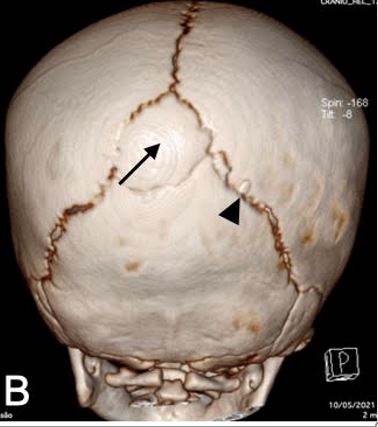Wormian bones and nonsyndromic craniosynostosis: A comparative study using computed tomography
DOI:
https://doi.org/10.46900/apn.v4i2(May-August).108Keywords:
Wormian bones, Craniosynostosis, CT scan, Anatomy, mild head traumaAbstract
Introduction: Wormian bones (WB) are accessory bones positioned within the sutures or fontanelles. Although several studies have associated them with genetic disorders, ethnicity, and skull deformations, their relationship with nonsyndromic craniosynostosis (CS) has not been established, especially among Brazilians. Therefore, this study was conducted to analyze the incidence and association of WB with nonsyndromic CS in Brazilian children.
Methods: An observational and retrospective study was conducted using computed tomography with 3D reconstruction in Brazilian children aged <3 years to compare the incidence and number of WB between regular children (group 1) and those with nonsyndromic CS (group 2).
Results: A total of 140 children, comprising 62.9% boys (p < 0.001) with a mean age of 8.78 months, were included in this study. The most common types of CS were trigonocephaly (34; 48.6%), scaphocephaly (25; 35.7%), anterior plagiocephaly (5; 7.1%), posterior plagiocephaly (3; 4.2%), and brachycephaly (3; 4.2%). WB were more common in regular children (41; 58.6%) than in children with CS (28; 40.0%) (p = 0.028). Regular children had an average of 2.12 WB versus 1.32 WB in children with nonsyndromic CS (p = 0.024).
Conclusion: The significantly less incidence of WB in Brazilian children with nonsyndromic CS was quite different from that reported in other studies and could indicate the tendency of this disease to have disturbance in ossification of the cranial vault, the impact of ethnicity, and probably the lack of additional compensatory skull growth.
Downloads

Additional Files
Published
How to Cite
Issue
Section
Categories
License
Copyright (c) 2022 Leopoldo Mandic Furtado, José Aloysio da Costa Val Filho, Rayane Toledo Simas, François Dantas, Julia Braga Holliday, Júlia da Silva Costa, Aieska Kellen Dantas dos Santos

This work is licensed under a Creative Commons Attribution 4.0 International License.

When publishing in Archives of Pediatric Neurosurgery journal, authors retain the copyright of their article and agree to license their work using a Creative Commons Attribution 4.0 International Public License (CC BY 4.0), thereby accepting the terms and conditions of this license (https://creativecommons.org/licenses/by/4.0/legalcode).
The CC BY 4.0 license terms applies to both readers and the publisher and allows them to: share (copy and redistribute in any medium or format) and adapt (remix, transform, and build upon) the article for any purpose, even commercially, provided that appropriate credit is given to the authors and the journal in which the article was published.
Authors grant Archives of Pediatric Neurosurgery the right to first publish the article and identify itself as the original publisher. Under the terms of the CC BY 4.0 license, authors allow the journal to distribute the article in third party databases, as long as its original authors and citation details are identified.





























